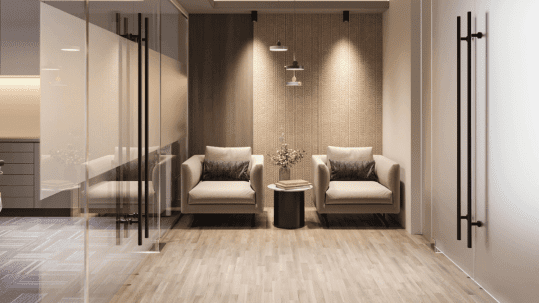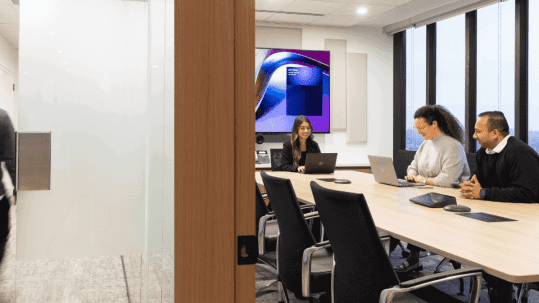When businesses are fresh and new, they typically put in miles of extra effort to track and chart all expenses so they know where every last red cent has gone. As time goes on and growth happens, budgets inevitably increase and with them, so does spending. Every now and then a professional space audit can help reduce costs in the office, doing so by looking closely at business operations, productivity, and workflow.
A professional space audit can reduce costs by exposing those areas of over spending that have expanded with your business – a space audit can also mean investigating how well/poorly office spaces are used, creating a lapse in productivity, impacting profitability, and affecting growth.
What is a Space Audit?
A professional space audit paints a portrait of the space details within an office environment to evaluate the efficiency of that space and how well it’s used. Office space auditors regularly track and compare space usage, and costs over time to systematically find ways to better use space, reducing costs and boosting efficiency.
How Does it Benefit Businesses?
Space audits benefit businesses in a plethora of ways:
- They estimate the usefulness of office layouts and floor plans
- They improve the utility of an office to better use space and lower leasing/renting costs
- Enhance use of extra space, storage capabilities, and even the utility of parking lots, lobbies, and common rooms.
- They track and record how misused space can cost organizations over time, citing inefficiencies as opportunities to make beneficial changes.
Lastly, there’s a cultural, and/or mental benefit to a professional space audit. By working with an office space auditor to optimize spatial usage, it is a mental boost to a businesses’ outlook on the future. Knowing full well that your organization is taking a step towards better using its existing space to optimize efficiency, usage, and reduce costs is a true breath of fresh air.
The Process
Planning
There are four key steps to a professional space audit, and an office space auditor will walk you through each component to explain their findings.
- Before things can get started, you’ll need a comprehensive pre-space audit review of the office space as it sits. This review is meant to verify that all space allocations to each department are in use.
- Select the office environment to be audited by creating a master audit record that includes all of the necessary information the office auditor will need, including: the time period the audit will take place, the process to be used by the auditor, spaces and/or floors within the office to be audited. Once the master record is complete, the audit may begin.
Organizations can be proactive in the planning stage of their space audit by collaborating with, and speaking to employees to discover any preconceived notions of particular spaces that are not used well. This could mean finding that staff don’t have appropriate space to use as designated focus areas, or that they feel the open concept space they have access to lacks in technology availability, or applicable connectivity. It could also mean they find there isn’t enough space for organized storage, or a lacklustre common area.
This info can help your business to plan with the office auditor to investigate efficiencies for specific employee spaces within the office.
Preparation
- Begin processing the office spaces outlined in the master audit. There are two distinct space audit processes here:
- Active
- Inactive
Active space allocation means evaluating allocated spaces only, generating a quicker allocation history record. Inactive space allocation processes take longer to complete, as they audit all spaces.
- Review the audit. This is where the fruits of your collective labour come forward.
How Can Space Audits Save Costs?
A space audit can help save costs on Design-Build phases of your office transition by closely investigating the usefulness and efficiencies/inefficiencies that generate within office spaces over time. As businesses get comfy and settle into a predictable operational routine, spaces are routinely altered – sometimes for the better, and sometimes for the worse – this contributes to space inefficiencies, and a loss of productivity – resulting in lost revenue.
Companies may also choose to audit warehousing space and storage within the office space – some may even choose to divest from massive unused brick and mortar buildings to embrace a remote-friendly, smaller mobile workspace for their employees. This lean approach to space-saving helps save costs on overhead, rent/lease payments, and insurance.
Alternatively, a space audit may find that your business has been inaccurately hoarding inventory, tying up much-needed capital. This optimistic outlook usually results in inflated inventory that may sit unused for months at a time. Part of the audit solutions therein could include making smaller more frequent purchases to optimize storage space, eliminate outgoing costs, and fine-tuning spending within the office.
In this sense, space audits are closely related to professional space planning, a creative methodology that uses innovative interior design to maximize the efficiency of office layouts. Using space more effectively is directly ties to:
- Productivity
- Growth
- flexibility/adaptability
Space planning and space audits are similar because both seek to optimize space use and minimize spending streams by solving problems linked to physical operation of office environments.
—
How we interact with our spaces is never a concrete relationship – office spaces need to adapt and change with us to keep up with the demands of thriving, growing businesses – and professional space audits can reduce costs and help struggling businesses to boost their effectiveness at the same time.






